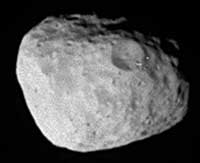
Saturn X - 1980S1
Janus [JAY-nus] is the sixth satellite of Saturn. It was discovered by Audouin Dollfus in 1966 and was named after the god of gates and doorways. It is depicted with two faces looking in opposite directions. Janus has an irregular shape with a size of 196x192x150 kilometers (122x119x93 miles) in diameter. It is heavily cratered with several craters 30 kilometers (19 miles) in diameter. The pervasive cratering indicates that its surface must be several billion years old. Prometheus appears to have fewer craters indicating a younger surface while Pandora appears to have an older surface. Janus has few linear features.
Janus and Epimetheus share the same orbit of 151,472 kilometers (94,125 miles) from Saturn's center or 91,000 kilometers (56,547 miles) above the cloud tops. They are only separated by about 50 kilometers (31 miles). As these two satellites approach each other they exchange a little momentum and trade orbits; the inner satellite becomes the outer and the outer moves to the inner position. This exchange happens about once every four years. Janus and Epimetheus may have formed from a disruption of a single parent to form co-orbital satellites. If this is the case, the disruption must have happened early in the history of the satellite system.
| Janus Statistics | |
|---|---|
| Discovered by | Audouin Dollfus |
| Date of discovery | 1966 |
| Mass (kg) | 2.01e+18* |
| Mass (Earth = 1) | 3.3635e-07 |
| Radius (km) | 98x96x75 |
| Radius (Earth = 1) | 1.5365e-02 |
| Mean density (gm/cm^3) | 0.67* |
| Mean distance from Saturn (km) | 151,472 |
| Rotational period (days) | 0.6945 |
| Orbital period (days) | 0.6945 |
| Mean orbital velocity (km/sec) | 15.87 |
| Orbital eccentricity | 0.007 |
| Orbital inclination (degrees) | 0.14 |
| Escape velocity (km/sec) | 0.0523 |
| Visual geometric albedo | 0.8 |
| Magnitude (Vo) | 14.5 |
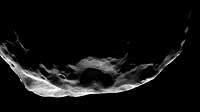 Profile of Janus
Profile of Janus
This shadowy scene is one of the Cassini spacecraft's closest views of
Saturn's moon Janus.
The slopes of some craters here display hints of the darker material better seen on Epimetheus in PIA09813. A bright linear feature runs up the wall of the large crater at bottom center.
The view looks toward southern latitudes on Janus (179 kilometers, or 111 miles across). North is toward the top of the image and rotated 58 degrees to the right.
The image was taken in visible light with the Cassini spacecraft
narrow-angle camera on June 30, 2008. The view was obtained at a distance
of approximately 33,000 kilometers (21,000 miles) from Janus and at a
Sun-Janus-spacecraft, or phase, angle of 120 degrees. Image scale is 200
meters (656 feet) per pixel.
(Courtesy NASA/JPL/Space Science Institute)
 Janus Up Close
Janus Up Close
From just beneath the ringplane, Cassini stares at Janus (181 kilometers,
or 113 miles across).
The image was taken in visible light with the Cassini spacecraft
narrow-angle camera on April 29, 2006 at a distance of approximately
218,000 kilometers (135,000 miles) from Janus. Image scale is about 1 kilometer (0.6
mile) per pixel.
(Courtesy NASA/JPL/Space Science Institute)
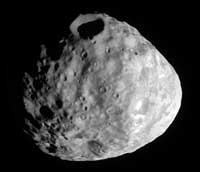 Crater View
Crater View
The Cassini spacecraft eyes a prominent crater on the moon Janus.
The south pole lies on the terminator at the bottom left of the image. This view is centered on terrain at 16 degrees south latitude, 64 degrees west longitude. This view looks toward the leading hemisphere of Janus (179 kilometers, or 111 miles across). North on Janus is up and rotated 31 degrees to the right.
The image was taken in visible light with the Cassini spacecraft
narrow-angle camera on July 26, 2009. The view was acquired at a distance
of approximately 98,000 kilometers (61,000 miles) from Janus and at a
Sun-Janus-spacecraft, or phase, angle of 58 degrees. Image scale is 586
meters (1,922 feet) per pixel
(Courtesy NASA/JPL/Space Science Institute)
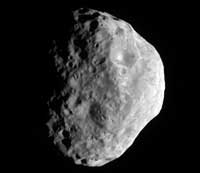 Janus' Cratered South
Janus' Cratered South
The Cassini spacecraft looks toward the south pole and cratered surface of
Saturn's moon Janus.
The pole of Janus lies on the terminator about one-third of the way inward from the bottom of the image. This view is centered on terrain at 42 degrees south latitude, 32 degrees west longitude. Lit terrain seen here is on the Saturn-facing side of Janus (179 kilometers, or 111 miles across).
The image was taken in visible light with the Cassini spacecraft
narrow-angle camera on July 26, 2009. The view was acquired at a distance
of approximately 100,000 kilometers (62,000 miles) from Janus and at a
Sun-Janus-spacecraft, or phase, angle of 63 degrees. Image scale is 600
meters (1,968 feet) per pixel.
(Courtesy NASA/JPL/Space Science Institute)
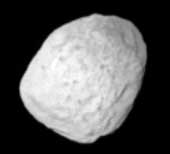 Spots on Janus
Spots on Janus
This close-up look at Saturn's moon Janus reveals spots on the moon's
surface which may be dark material exposed by impacts. If the dark
markings within bright terrain are indeed impact features, then Janus'
surface represents a contrast with that of Saturn's moon Phoebe, where
impacts have uncovered bright material beneath a darker overlying layer.
Janus is 181 kilometers (113 miles) across.
Janus may be a porous body, composed mostly of water ice.
This image was taken in visible light with the Cassini spacecraft
narrow-angle camera on May 20, 2005, at a distance of approximately
357,000 kilometers (222,000 miles) from Janus and at a
Sun-Janus-spacecraft, or phase, angle of 6 degrees. Resolution in the
original image was 2 kilometers (1 mile) per pixel. The view was
magnified by a factor of two and contrast-enhanced to aid visibility of
the moon's surface.
(Courtesy NASA/JPL/Space Science Institute)
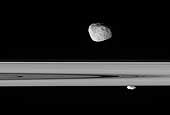 So Close
So Close
Saturn's moons Janus and Prometheus look close enough to touch in this
stunningly detailed view.
From just beneath the ringplane, Cassini stares at Janus (181 kilometers, or 113 miles across - on top) on the near side of the rings and Prometheus (102 kilometers, or 63 miles across - on bottom) on the far side. The image shows that Prometheus is more elongated than Janus.
The view takes in the Cassini Division (4,800 kilometers, or 2,980 miles
wide), from its outer edge to about halfway across its width.
(Courtesy NASA/JPL/Space Science Institute)
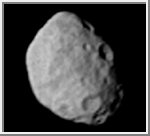 Janus Viewed from Voyager 2
Janus Viewed from Voyager 2
This image of Janus was acquired by the Voyager 2 spacecraft on
August 25, 1981. It is the highest resolution image available.
(Copyright Calvin J. Hamilton)
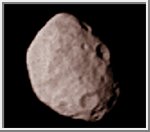 Pseudo Color Image of Janus
Pseudo Color Image of Janus
This is a colorized version of the high resolution Voyager 2 spacecraft
image of Janus that was taken on August 25, 1981.
(Copyright Calvin J. Hamilton)
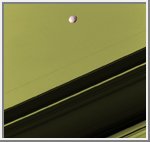 Janus With Saturn's Rings in the Background
Janus With Saturn's Rings in the Background
This Voyager 1 picture was taken of Janus in front of Saturn's rings.
It was acquired on November 12, 1981.
(Copyright Calvin J. Hamilton)
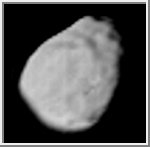 Janus
Janus
This image of Janus was acquired by the Voyager 1 spacecraft on
November 12, 1981.
(Copyright Calvin J. Hamilton)
 Simple Cylindrical Map of Janus
Simple Cylindrical Map of Janus
This image is a Simple Cylindrical map of Janus centered at 180 degrees
longitude. It was constructed from Voyager 1 and Voyager 2 pictures of Janus
using a shape model of Peter Thomas.
(Courtesy A. Tayfun Oner)
 Topographic Map of Janus
Topographic Map of Janus
This is a topographic map of Janus. It is based upon the shape model by Phil
Stooke. As with all maps, it is the cartographer's interpretation;
not all features are necessarily certain given the limited data
available. This interpretation stretches the data as far as possible.
(Courtesy A. Tayfun Oner)
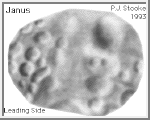 Conformal Projection of Janus
Conformal Projection of Janus
This image is a shaded relief map of Janus, the larger co-orbital
satellite of Saturn. As with all maps, it is the cartographer's
interpretation and not all features are necessarily certain given the
limited data available. This interpretation stretches the data as far as
is feasible. The image shows two different views of Janus in a
Morphographic Conformal Projection. One view shows the
leading side and the
other the trailing side.
(Courtesy Phil Stooke/NSSDC/NASA)
Stooke, P. J. and Lumsdon, M. P., "The Topography of Janus," Earth, Moon and Planets, 62 (1993), 223-237.

 Saturn
Saturn Epimetheus
Epimetheus Mimas
Mimas